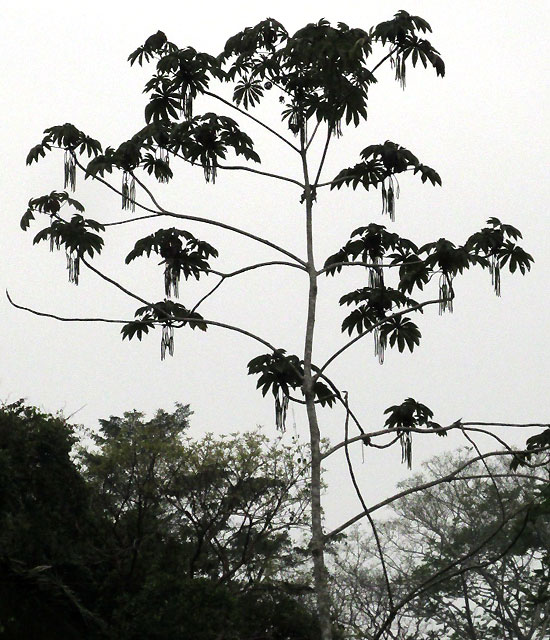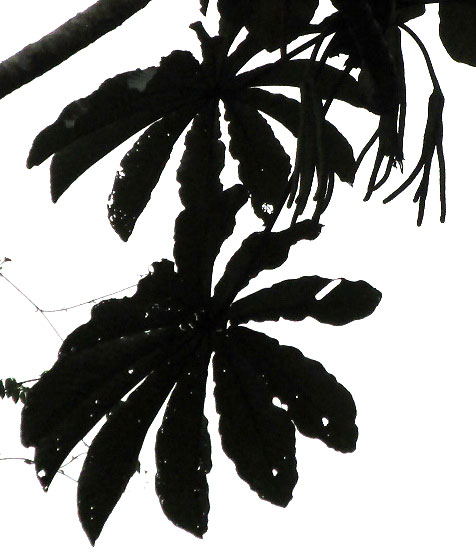Excerpts from Jim Conrad's
Naturalist Newsletter
from the April 27, 2019 Newsletter with notes from an early April camping trip in northern Guatemala's Petén department; tropical rainforest, elevation ~220m (~720 ft), ~N16.492°, W90.209°

CECROPIA
At www.backyardnature.net/yucatan/cecropia.htm we look at the fast-growing, very distinctive-looking and easy-to-recognize, handsome, "weed tree" variously known as the Cecropia, Guarumo, Trumpet Tree, Umbrella Tree, Snakewood, and by other names. It bears so many names because it's so conspicuous along roadsides and in weedy fields throughout most of humid, lowland tropical America, where it's native, plus it's escaped as an invasive in many other tropical countries wordwide. It's Cecropia peltata," a good old Linneaus name.
This month on April 2nd as I hiked out of Seibal Archaeological Park about 15kms east of Sayaxché in northern Guatemala's Petén department, a second Cecropia species turned up, one I've been looking for for a long time. Above, it's shown silhouetted against a dense morning fog.
Though the tree's general form, its deeply palmately lobed leaves and roadside habitat were very similar to Cecropia peltata, even at a distance it was clearly a different species. The key field mark separating it from Cecropia peltata is the dangling items looking like limp hands with extremely slender fingers. Those are flowering heads, or inflorescences, composed of downward-hanging spikes of tiny female flower ovaries maturing into many crammed-together fruits. Below, a closer look is afforded of both flowering structures and leaves:

If you compare this cecropia's flowering/fruiting structures with those on our Cecropia peltata page, you'll see that the ones of this Guatemalan species are much longer and narrower. Also, the leaves of the Guatemalan species tend to have more lobes that are more slender.
Our Guatemalan species is CECROPIA OBTUSIFOLIA, going by the same English names as Cecropia peltata. Like the other Cecropia, Cecropia obtusifolia is native throughout much of tropical America, and similarly is invasive in other tropical countries. However, at least in our area, it doesn't seem to be as successful in invading disturbed habitat as Cecropia peltata.
In the Yucatan, both cecropia species are absent in the peninsula's arid northwestern corner. At my present home in central Yucatan north of Valladolid, Cecropia peltata commonly occurs in moist sinkholes, or cenotes, and sometimes in especially humid, disturbed upland spots. However, the presently considered Cecropia obtusifolia is absent. According to records of collected plants, it appears that both species occur regularly in the rainier eastern and southern Yucatan. In short, the present Cecropia obtusifolia seems to need more rainfall than Cecropia peltata.